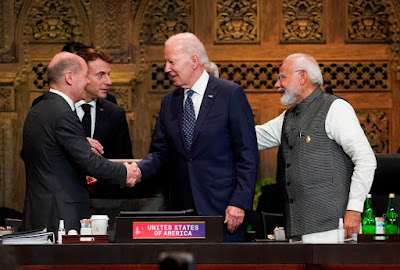Bharat, which takes the place of the word "India," commands attention at the G20 Summit.
The G20 Summit, a forum for the discussion of economic and global issues that brings together the world's major economies, also serves as a platform for the display of diplomatic symbolism and cultural identity. The country tag at Prime Minister Narendra Modi's table during his opening remarks at the G20 Summit read "Bharat" rather than the more typical "India," which was a notable deviation from tradition. This seemingly insignificant modification has important historical, cultural, and diplomatic ramifications. In this article, we will examine the causes of this change as well as the larger context in which it occurs.
Historical Importance of the Term "Bharat" :
It is crucial to realize that "Bharat" is not a brand-new or arbitrary name for India; rather, it has deep historical and cultural roots that date back thousands of years in order to comprehend the significance of this change. According to "Bharat: The Mother of Democracy," a glossy 24-page magazine handed out at the G20 Summit, "Bharat" is the name of the nation as it is spelled out in the Indian Constitution and expressed in discussions that took place before the constitution was adopted in the late 1940s.
In the past, the Indian subcontinent was referred to as "Bharatvarsha," hence the use of the word "Bharat." This name has a long history that highlights the persistence of Indian civilization over millennia. It represents India's historical and cultural identity and is more than just a name.
A Shift in International Identity :
The decision to prominently display "Bharat" at the G20 Summit is a clear indication of how India wishes to be recognized on the global stage. While "India" has been the widely accepted name in international diplomacy and interactions, "Bharat" is now being presented as the preferred and official name in such contexts.
This shift is not merely a matter of semantics; it signifies a broader desire to assert India's historical and cultural identity. By using "Bharat," the country aims to emphasize its deep-rooted heritage and its place as one of the world's oldest and most enduring civilizations. It seeks to remind the global community of its rich history, diverse culture, and democratic values that have evolved over thousands of years.
A Magazine Reflecting India's Heritage :
The magazine "Bharat: The Mother of Democracy," produced especially for the G20 Summit, serves as a medium to showcase India's historical journey. In its glossy 24 pages, it delves into the country's ancient roots, tracing the beginnings of the Indian civilization to the "Sindhu-Saraswati civilization," commonly known as the "Indus Valley Civilization," dating back to 6000 BCE–2000 BCE.
The magazine's contents extend beyond archaeology and ancient history. It explores key historical eras, such as the Ramayana and the Mahabharata, which have had a profound impact on India's culture, philosophy, and values. These epic narratives are not just myths; they are integral to India's identity, serving as moral and ethical compasses for generations.
Furthermore, the magazine provides insights into India's contributions to philosophy, religion, and culture. It acknowledges figures like Fa Hsien, the Chinese monk who undertook a remarkable journey to India in the 5th century CE, documenting his observations and interactions. This historical account underscores India's role as a hub of knowledge and spirituality, attracting scholars and seekers from across the world.
The magazine also highlights significant periods in India's history, such as the Mahajanapada and the concept of Gantantra (democracy) in the 7th and 8th centuries BCE. It delves into the spread of Buddhism and Jainism, two major philosophical and religious movements that originated in ancient India. These traditions have left a profound mark not only on the subcontinent but also on global spirituality and ethics.
One of the magazine's noteworthy inclusions is the mention of Megasthenes, the Greek explorer who visited India during the time of the Mauryan Empire. His accounts provide valuable insights into ancient Indian society, governance, and culture.
Moving forward in time, the magazine discusses Kautilya and his seminal work, the Arthashastra, an ancient treatise on statecraft, economics, and politics. Kautilya's teachings continue to influence modern governance and strategic thinking.
Afterward, the magazine touches upon the Vijayanagara Empire, which thrived in southern India during the 14th to 16th centuries. This empire is celebrated for its cultural richness and architectural marvels.
A noteworthy inclusion in the magazine is the section titled "The Understanding Monarch," where it acknowledges the Mughal Emperor Akbar. The passage describes Akbar's commitment to good governance, emphasizing that "administration should embrace everyone's welfare, regardless of religion." Akbar's approach to governance is characterized as democratic, progressive, and ahead of its time. This acknowledgment underscores the magazine's effort to portray a holistic view of India's historical narrative.
Conclusion:
The decision to use "Bharat" instead of "India" at the G20 Summit is more than just a change in nomenclature; it represents a conscious effort to reaffirm India's historical and cultural identity on the global stage. While "India" remains a widely accepted and recognized name, "Bharat" is emerging as a powerful symbol of India's enduring legacy.
Through the magazine "Bharat: The Mother of Democracy," India aims to showcase its historical journey, emphasizing its democratic ethos and the richness of its heritage. It seeks to remind the world that India's identity is deeply rooted in its ancient past, where philosophy, spirituality, and democratic principles have flourished for thousands of years.
As India navigates the complexities of the modern world, it does so with a renewed sense of pride in its heritage and a desire to share its profound cultural narrative with the international community. The shift to "Bharat" signifies not just a name change but a statement of identity, an assertion of continuity, and an invitation to explore the timeless traditions and values that have shaped India into the nation it is today. In an increasingly interconnected world, understanding and appreciating this rich tapestry of history and culture is more important than ever.






.jpeg)
0 Comments